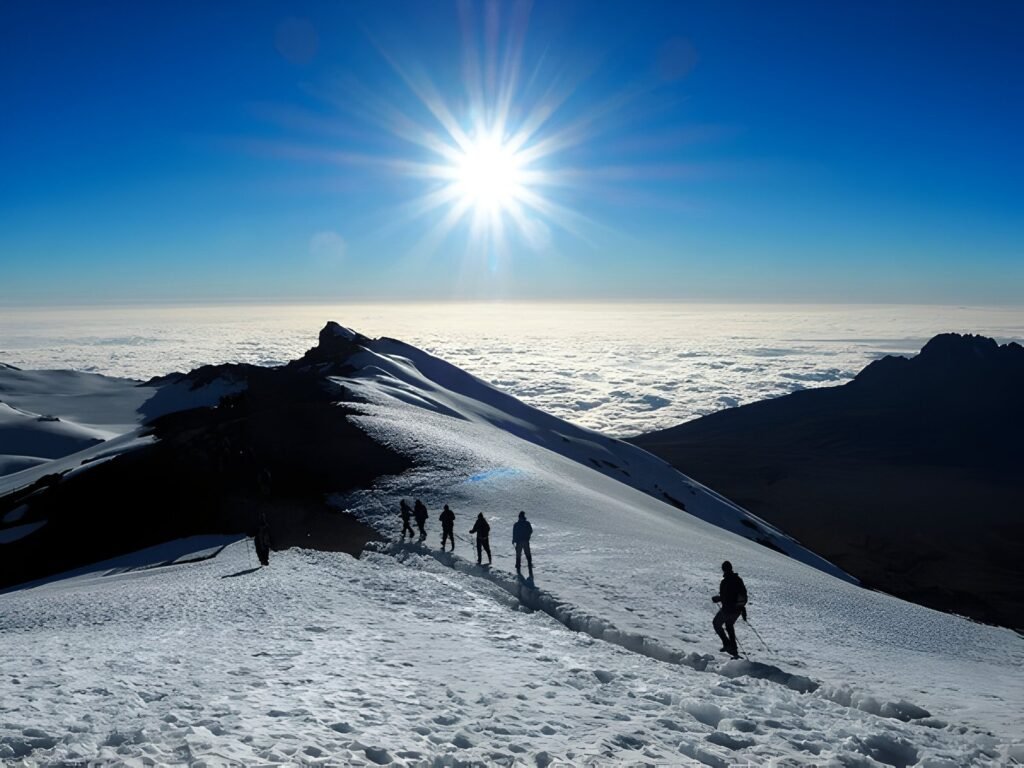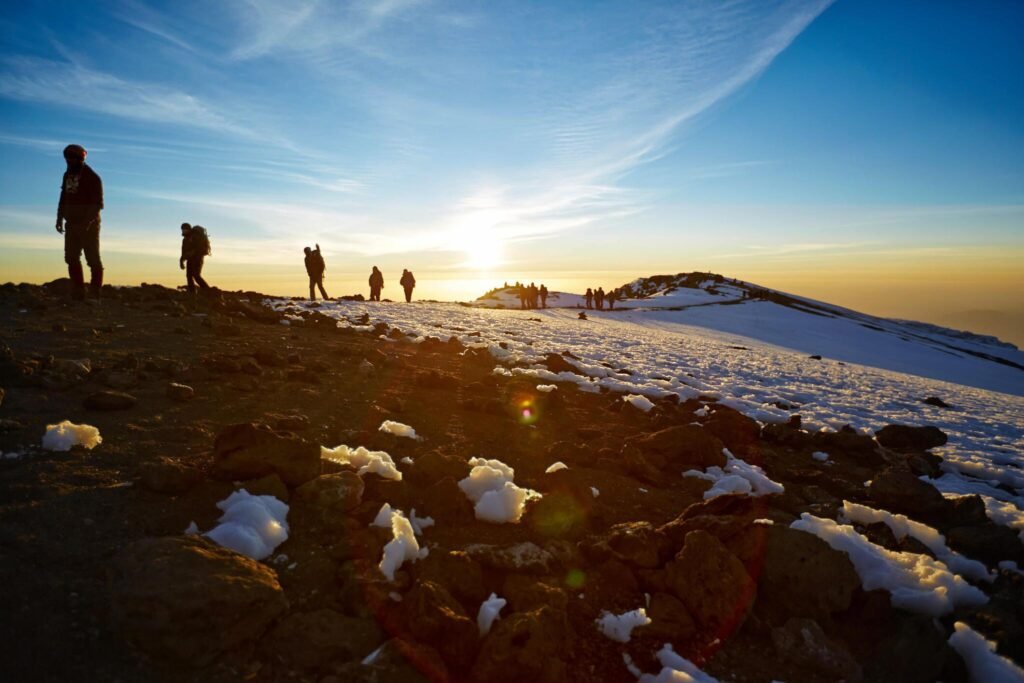Why Do Climbers Summit Kilimanjaro at Night ? Climbing Mount Kilimanjaro, Africa’s tallest peak, is a life-changing adventure. One of the most fascinating aspects of this journey is that the final ascent to the summit typically happens at night. Many climbers wonder, why do climbers summit Kilimanjaro at night? In this guide, we’ll explore the reasons behind this tradition, the benefits of a nighttime summit push, and how to prepare for this unique experience.

Why Do Climbers Summit Kilimanjaro at Night ? : Reaching the Summit at Sunrise
One of the main reasons for summiting Kilimanjaro at night is to reach the top just as the sun rises. The sight of the sun rising over the vast African landscape from the summit, Uhuru Peak, is a breathtaking reward after hours of climbing in the dark. The early morning light reveals the stunning glaciers around you and provides panoramic views of Tanzania and even as far as Kenya.
- Uhuru Peak (5,895 meters): The highest point on the mountain, and reaching it at dawn offers a magical experience that climbers cherish for a lifetime.
Learn more about Kilimanjaro sunrise climbs with Kilimanjaro Climb Specialist
Why Do Climbers Summit Kilimanjaro at Night ? : Avoiding the Intense Midday Heat
While the summit of Kilimanjaro is frigid, the lower slopes of the mountain can become quite warm during the day. By making the final ascent during the cool night, climbers can avoid the intense midday heat that can be draining and exhausting, especially during the descent.
- Temperature Advantage: Climbing at night allows you to move in cooler conditions, making the ascent more manageable.
- Descending in Daylight: Once you’ve reached the summit at sunrise, you descend in the daylight, which not only helps with visibility but also lets you enjoy the views without the extreme heat.
Explore how to prepare for the temperatures on Kilimanjaro at Eddy Tours Safaris
Why Do Climbers Summit Kilimanjaro at Night ? : Better Chances of Clear Skies
The weather on Kilimanjaro is unpredictable, but the early morning hours often provide clearer skies compared to later in the day. Summiting at night increases the likelihood of seeing a cloudless sky, offering spectacular views from the top. By the afternoon, clouds can roll in, obstructing the view and making the experience less memorable.
- Stargazing Opportunities: During the night climb, you’ll have the rare opportunity to gaze at the bright African stars, free from light pollution. The Milky Way often stretches across the sky, adding to the magic of the ascent
Read more about stargazing on Kilimanjaro
Why Do Climbers Summit Kilimanjaro at Night ? : Timing for Acclimatization and Rest
Most routes up Kilimanjaro are designed to provide proper acclimatization, allowing your body to adjust to the high altitude. Climbers typically arrive at Barafu Camp or Kibo Hut, the final base camp, in the afternoon, giving them time to rest and acclimatize before making the final push at midnight.
- Midnight Start: Starting the climb at midnight gives climbers around 6 to 8 hours to reach the summit by sunrise. This schedule allows for plenty of time to acclimatize and gather energy for the difficult ascent.
- Rest Period: After descending from the summit back to the base camp, climbers have time to rest and reflect on their achievement before completing the descent to lower altitudes.
Discover how acclimatization works on Kilimanjaro
Why Do Climbers Summit Kilimanjaro at Night ? : Psychological Advantage of Climbing in Darkness
Climbing Kilimanjaro at night may seem daunting, but it can actually provide a psychological advantage. The darkness limits your vision to just the few steps ahead of you, helping to focus your mind on the immediate task and avoid the mental challenge of seeing the long, steep path up to the summit.
- Step-by-Step Focus: The limited visibility reduces the intimidation factor of seeing how much further you have to go, allowing climbers to focus solely on moving forward.
- Avoiding Fatigue: Since you’re not seeing the entire climb stretched out before you, it can help reduce the mental fatigue of knowing how far you still have to go.
Learn more about the mental aspects of Kilimanjaro climbs
Why Do Climbers Summit Kilimanjaro at Night ? : Safety Considerations for Night Climbs
Summiting Kilimanjaro at night also comes with specific safety advantages. The snow and ice near the summit are more stable and less likely to melt or shift during the cooler night hours, making the terrain safer for climbers. By the afternoon, the sun can melt ice patches, increasing the risk of slips and falls.
- Safer Terrain: Climbing on frozen ground is often safer than navigating the potentially slippery, thawing ground during the day.
- Guides’ Expertise: Kilimanjaro guides are highly experienced and know the best routes for nighttime climbs, ensuring that climbers remain safe while navigating in the dark.
Get safety tips for Kilimanjaro night climbs
Experiencing the Tranquility of the Mountain
Climbing at night also allows for a more tranquil experience. The silence of the mountain at night, combined with the stillness of the surroundings, creates a peaceful and reflective atmosphere. Many climbers find that the nighttime ascent offers a deep connection with nature, heightening the emotional impact of the summit.
- Personal Reflection: The quiet of the night allows for moments of personal reflection, as the climb becomes more introspective and meaningful.
- Group Unity: Climbers often feel a stronger sense of unity with their group during the nighttime ascent, as everyone moves together toward the common goal of reaching the summit.
Discover more about the emotional experience of Kilimanjaro climbs
Training for a Nighttime Ascent
To prepare for the challenges of summiting Kilimanjaro at night, climbers should consider night hikes in their training routine. This allows you to get used to navigating in the dark with a headlamp and builds your stamina for long, overnight hikes.
- Essential Gear: A high-quality headlamp, warm clothing, and layered gear are crucial for staying comfortable and safe during the nighttime ascent.
- Physical and Mental Preparation: Training for the altitude and cold temperatures, along with practicing hiking in darkness, ensures you are fully prepared for the summit push.
Explore the ultimate training guide for Kilimanjaro

Why Do Climbers Summit Kilimanjaro at Night ? : FAQs
1. What time do climbers usually start the nighttime summit of Kilimanjaro?
Most climbers start their final ascent between midnight and 1:00 AM to reach the summit by sunrise, which is typically around 6:00 AM
2. Is it safe to climb Kilimanjaro at night?
Yes, summiting Kilimanjaro at night is safe as long as you are guided by an experienced guide. The night climb allows for safer navigation of the ice and snow near the summit.
3. How cold is it during the nighttime ascent?
Temperatures at the summit can drop to -7°C to -29°C (20°F to -20°F) depending on the time of year, so it’s important to wear multiple layers to stay warm.
Get more information on summit night from Kilimanjaro Climb Specialist
Why Do Climbers Summit Kilimanjaro at Night ? : Plan Your Kilimanjaro Summit Night
Summiting Mount Kilimanjaro at night offers not only a practical advantage but also an emotional and rewarding experience. Whether it’s reaching the summit at sunrise, avoiding the heat, or moving in a focused, serene environment, night climbs are an integral part of what makes Kilimanjaro unique.
Start planning your Kilimanjaro adventure with Kilimanjaro Climb Specialist
Book your climb with Eddy Tours Safaris

